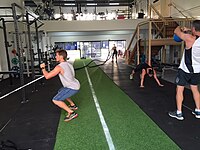Anaerobic exercise

Anaerobic exercise means exercising without using oxygen. When you do any physical activity, like running or jumping, you need energy to do it. Normally, your body uses oxygen to produce the energy needed to power your muscles. But when you do high-intensity activities that require a lot of energy quickly, like sprinting, your body can't get enough oxygen to your muscles fast enough. So instead, your body switches to a different process that creates energy without oxygen. That process is called anaerobic metabolism.
Anaerobic exercise can help you get stronger and faster, but it's also harder on your body than aerobic exercise (exercise that uses oxygen), and can make you feel tired more quickly. Examples of anaerobic exercises are weightlifting, sprinting, and high-intensity interval training (HIIT). When you do anaerobic exercise, your muscles create energy by breaking down glucose, a type of sugar that's stored in your muscles. This process also creates lactic acid, which can cause your muscles to feel sore and tired.
So, like when you run really fast or lift a heavy weight, your body needs to use different energy to be able to do it. And that's what anaerobic exercise is all about!
Anaerobic exercise can help you get stronger and faster, but it's also harder on your body than aerobic exercise (exercise that uses oxygen), and can make you feel tired more quickly. Examples of anaerobic exercises are weightlifting, sprinting, and high-intensity interval training (HIIT). When you do anaerobic exercise, your muscles create energy by breaking down glucose, a type of sugar that's stored in your muscles. This process also creates lactic acid, which can cause your muscles to feel sore and tired.
So, like when you run really fast or lift a heavy weight, your body needs to use different energy to be able to do it. And that's what anaerobic exercise is all about!
Related topics others have asked about:
